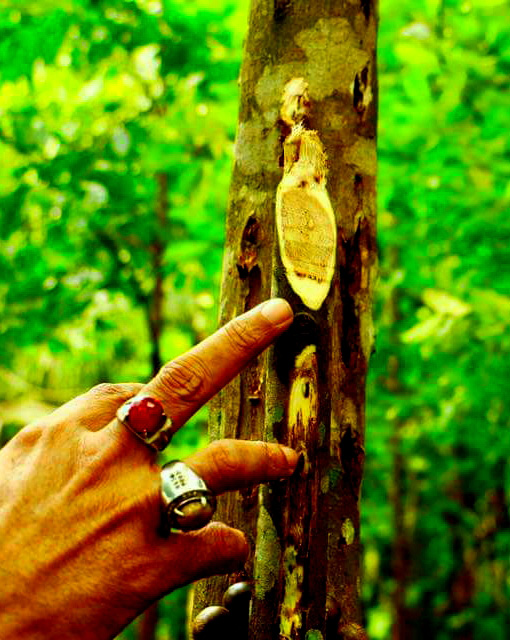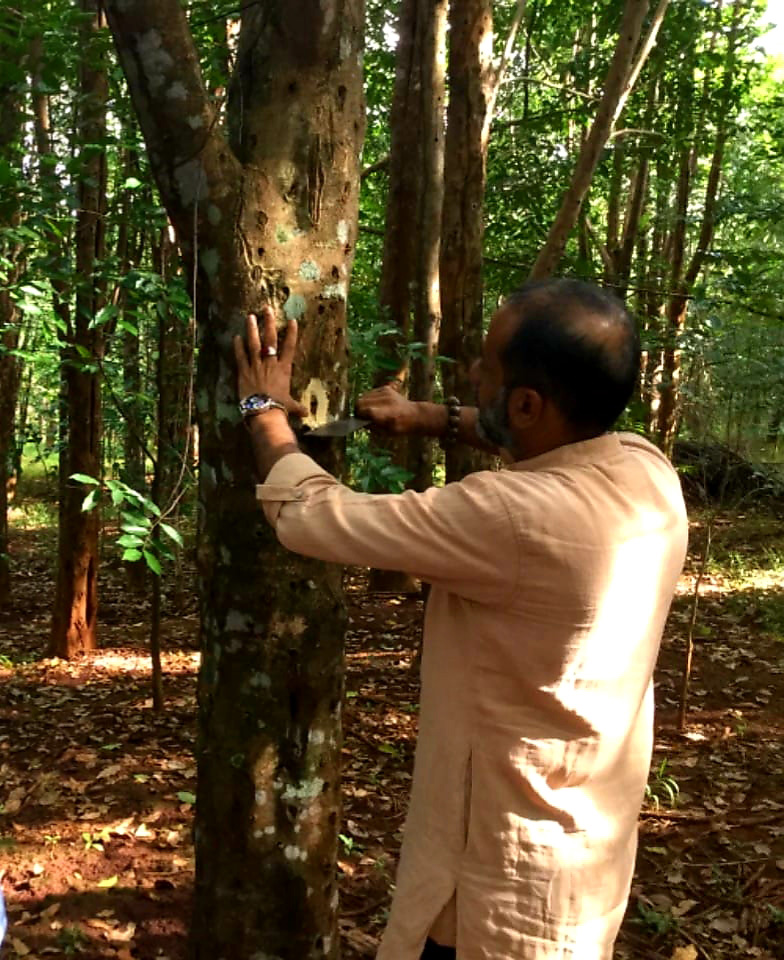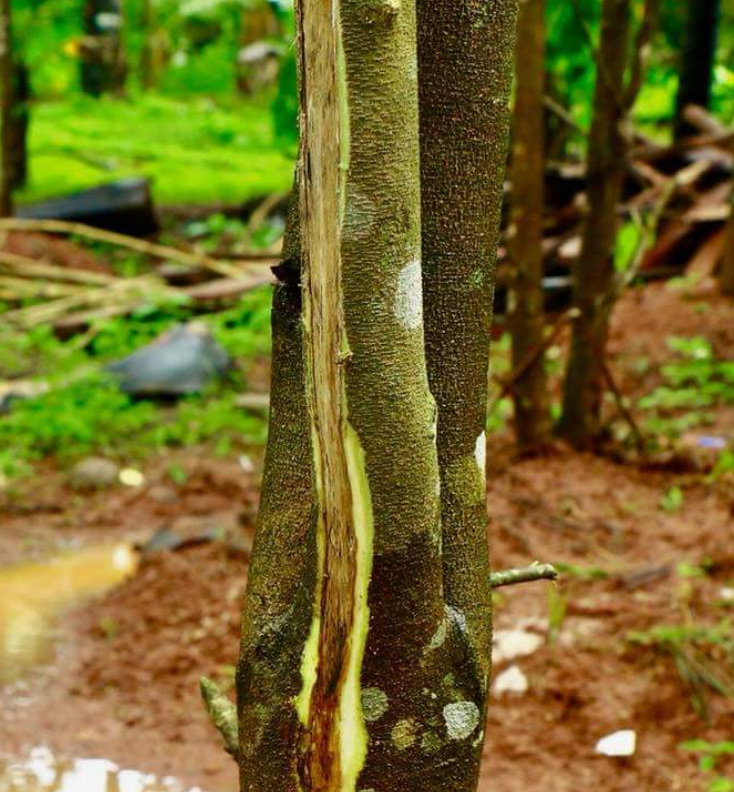Agarwoods Kerala Plantations-Producing Agarwood using Artificial Inoculation
Kerala based promoters of agarwood utilizes artificial inoculation to develop precious wood

Agarwood is the world’s most expensive agro-products. It is grown in almost all agro-climatic conditions. Original tree of agarwood is rare to find and costs more than gold or diamond. Alternatively it can be developed using artificial inject of fungus in aquilaria tree. “Less investment, no maintenance expenses, less labour intensive and high returns are unique features of aquilaria tree that makes it ideal forest tree for every farmer to consider growing it,” says Mr. Shamsudheen K.P, Founder and Director, Agarwoods Kerala Plantations.
Aquilaria Genus is best yielding variety amongst 15 other variants of same species to grow agarwood. The trees grow 6–20 m tall. The leaves are alternate, 5–11 cm long and 2–4 cm broad, with a short acuminate apex and an entire margin. The flowers are yellowish-green, produced in an umbel; the fruit is a woody capsule 2.5–3 cm long.
“Once aquilaria tree is 5 years plus it is infected with fungus. The process is known as artificial inoculation. The fungus infection inside the tree creates aromatic resin and gradually a resinous wood is produced. It is referred as agarwood,” elucidates Mr. Shamsudheen. All production methodologies are performed ensuring no-disturbance to the ecosystem and natural resources.

Three methods of artificial inoculation used at Agarwoods Kerala Plantations are F02P, F12S and F07D. All these three procedures have been researched and crafted by Mr. Shamsudheen. Sharing the details he says, “F02P is Pasting. In this we remove bark of the tree trunk and paste fungus. F12S is Sticking. We store fungus in bamboo sticks and insert the sticks all through the tree trunk. F07D is Drilling and Injecting. We inject fungus directly through the bottle.” Fungus injected is all natural free from chemicals. All three also vary with respect to price.
Manual injure or insect infestation in the stem leads to fungus infection. “To do so we have to wound the tree trunk, in these injuries fungus is injected. Stress condition in the tree enhances spreading infection so tree is pushed for the same. Consequently fungus infection through the damaged part of tree spreads and larger wood volume gets infected,” explicates Mr. Shamsudheen. “Colour around the wound changes from brown to dark implying infection process is progressing.” It usually takes 4-5 years for aquilaria tree to produce agarwood deep within its trunk.
Whether to harvest or not, is the most difficult decision as it is impossible to know from the outer appearance of the tree if the agarwood is produced inside the trunk or not! “Tree needs to be sick to produce agarwood so it is wounded manually. The symptoms of tree sickness are particularly die-back symptom on the top and outer branches and a yellow tint to the woody tissues. Visible wounds, stem distortion, smaller leaves and rotten branches also help in assurance of precious wood deposits inside the trunk,” he informs. “These symptoms imply sever fungus attack in aquilaria tree. Once these symptoms are seen easily then the tree opted for harvesting else left out if moderately sick.”

Once the tree is selected for harvesting, the trunk is cut down into 2 feet long logs. The logs are then segregated for infected and non-infected wood using indeginous tools. The infected logs carrying agarwood deposits are once again sorted out based on colour, odour, density and specific gravity. Sorted infected pieces are dried, white wood is removed, polished and graded in compliance with the market standards.
Agarwood is sold as barks, chips, sticks, powder and oil in the global market. Oil is obtained by the delicate process of distillation. “First and foremost the processed agarwood chips/sticks/powder is soaked in water and allowed to ferment. Later the entire mix is shifted in distillation kettles for steaming. Due to heat inside the kettle the oil starts floating on upper surface. Water and oil are separated with utmost care,” explains Mr. Shamsudheen. “Every single drop of agar essential oil is worth enormously. Even the by-products of this process fetch good price.” Price of agar oil in International market is around US$ 10 – 50 thousands/litre. To produce one litre agar oil approximately 400- 600 kg of agarwood is required.
Citing the reasons for huge global demand of agarwood he explains, “It is considered to have the finest natural aroma that makes it most sought-after wood. It is used for religious, cultural and medicinal purpose. The oil has rich medicinal properties to cure atrocious life threatening diseases.” Demand of agarwood had always been high and it shall continue to be in demand for many long years primarily in North-East Asia and West/Middle East Asia countries.

Agarwoods Kerala Plantations was started as research based organization in 2007 to conduct testing programs for suitability of agarwood cultivation in different climatic zones in India. “We found, it was easy to grow agarwood in almost all zones. We then started taking up plantation programs for commercial business,” shares Mr. Shamsudheen on foundation of the company for promoting commercial agarwood cultivation.
Company has recently inaugurated its International office at Perinthalmanna Malappuram District, Kerala. To help people grow the precious wood company provides seedlings, saplings, technology, production and marketing consultancy. In addition, “We sign a buy-back agreement with those who buy our seedling and take our consultancy. We offer the best rate to wood and its parts in comparison with the prevailing rates in the world market,” signs off Mr. Shamsudheen.